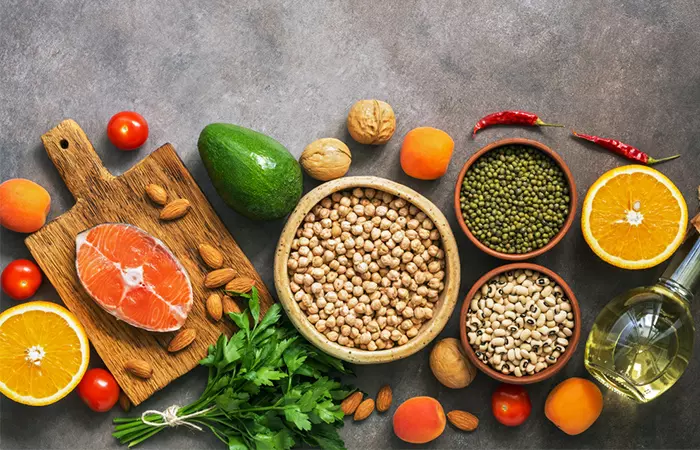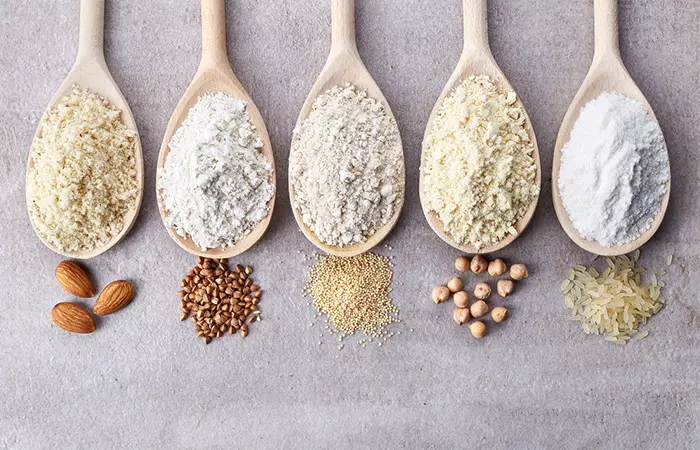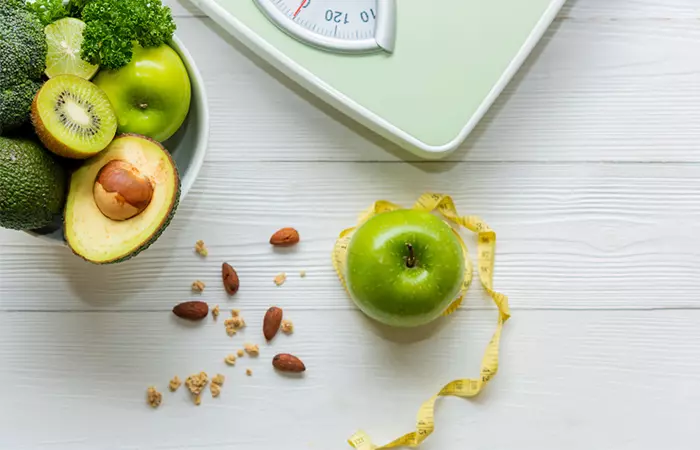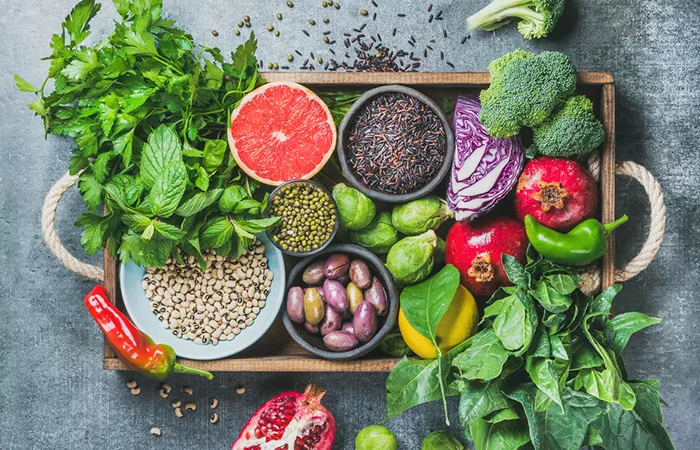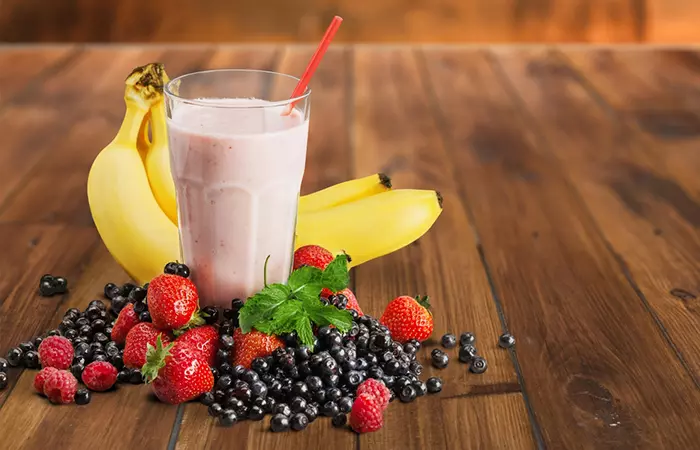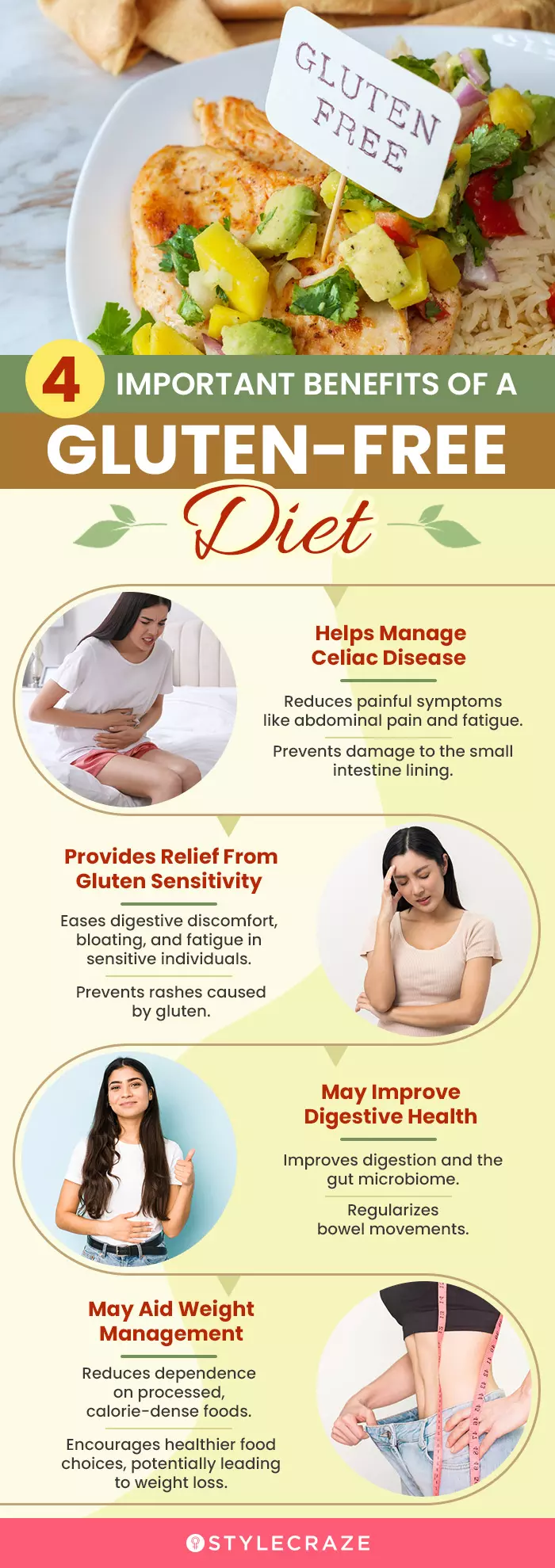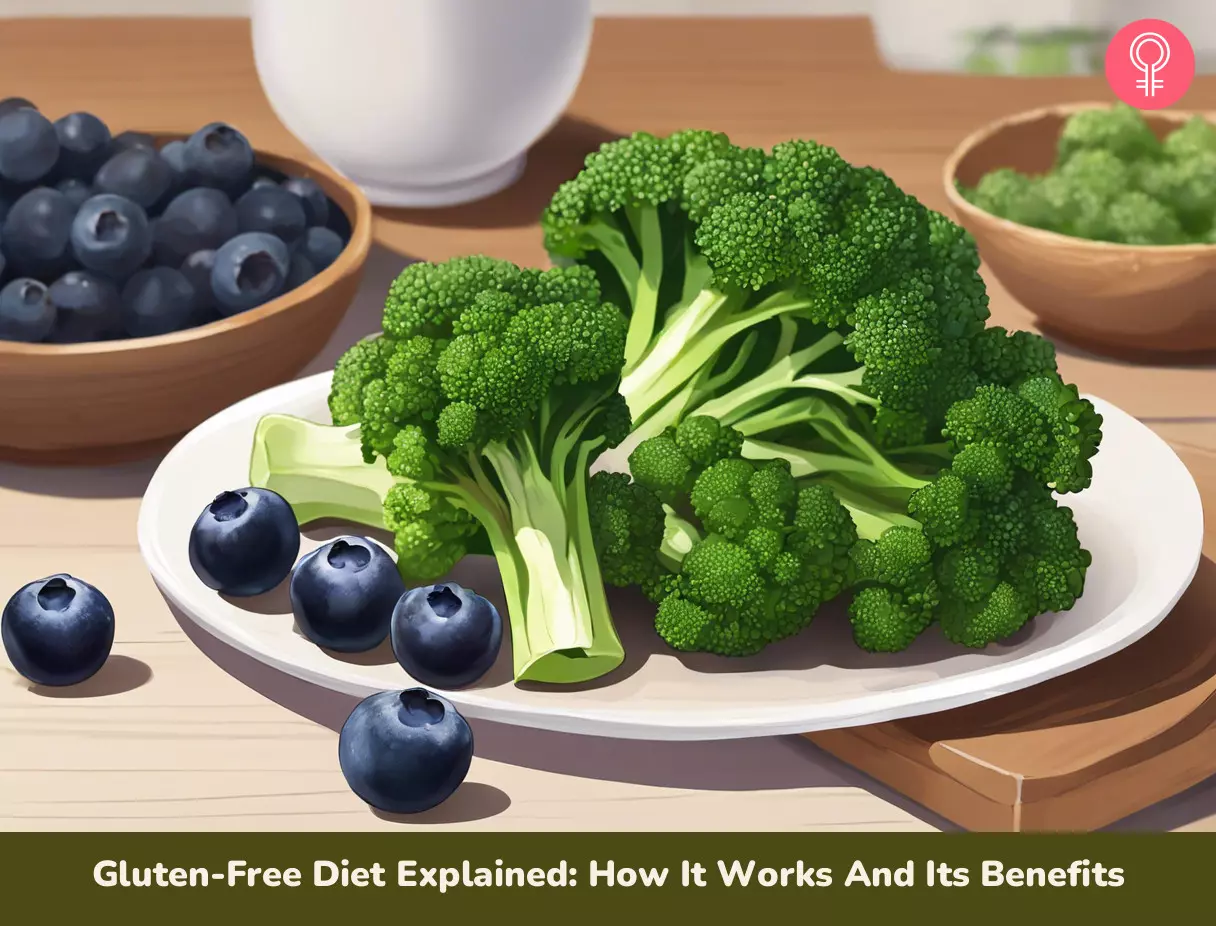What Is A Gluten-Free Diet?
A gluten-free diet is a comprehensive meal plan that cuts out gluten from your diet. Gluten is a protein found in grains like wheat, barley, rye, and their derivatives. While it is safe to consume for most people, it can cause painful and uncomfortable symptoms in people with celiac disease and gluten sensitivities (1). Thus, a gluten-free diet plan excludes all food items containing the aforementioned grains, like bread, pretzels, bagels, pasta, cookies, etc. It includes more naturally gluten-free grains, fruits, vegetables, legumes, and proteins such as meat, fish, and poultry. Many people mistakenly equate ‘gluten-free’ with ‘healthier,’ but the reality is that unless someone has a medical necessity to avoid gluten, it does not necessarily make a food choice healthier. Check out how this diet works in the next section.
How Does A Gluten-Free Diet Work?
The fundamental principle of a gluten-free diet involves eliminating gluten from your diet completely to avoid unwanted reactions. The first step to follow in this diet is to carefully select the food items and read all the food labels to ensure they are certified gluten-free. Hence, avoid all hidden sources of gluten, such as durum, semolina, and graham flour, and all wheat-based products, such as bread and pasta. Instead, look for their healthy and naturally gluten-free alternatives, like quinoa, corn, and rice flour, and switch to a diet rich in vegetables, fruits, fish, poultry, legumes, meat, nuts, and dairy. Scroll down to the next section to find out why switching to a gluten-free diet is a good idea.
Benefits Of A Gluten-Free Diet
This diet offers several benefits, particularly for individuals who have specific medical conditions or food sensitivities.
Helps Manage Celiac Disease
The most important advantage of a gluten-free diet is the effective management of celiac disease. Celiac disease is an autoimmune gastrointestinal condition, whereby the small intestine gets inflamed and damaged due to gluten ingestion (2), (3). This is a widely prevalent condition that is steadily being more and more recognized due to improved diagnosis methods. A study found that 1% of the Western population has been diagnosed with celiac disease (4). Adhering to a gluten-free diet can help prevent long-term health complications and improve the quality of life for such patients (5).
Provides Relief From Gluten Sensitivity
Some people experience non-celiac gluten sensitivity, which causes digestive discomfort, fatigue, and other symptoms. It is estimated that 0.5-13% of the general population experiences non-celiac gluten sensitivity (6). Going gluten-free can alleviate symptoms of irritable bowel, bloating, and rashes to improve overall well-being (7).
May Improve Digestive Health
Eliminating gluten may improve digestion, reduce bloating, and relieve gastrointestinal problems. A study done on a low-gluten diet (2g/day) showed that it helped alter the gut microbiome, reduced fasting and postprandial hydrogen exhalation, and reduced bloating in healthy adults. However, further research is warranted to prove the same for a completely gluten-free diet (8).
Aids Weight Loss
A gluten-free diet can promote weight loss for some individuals as it encourages the consumption of whole, natural, gluten-free foods like fruits, vegetables, and lean proteins while reducing processed and high-calorie gluten-containing foods. A study found that following a gluten-free diet for a year resulted in weight loss and reduction in waist circumference (9).
May Improve Skin Health
A gluten-free diet may help alleviate the symptoms of certain skin conditions and improve overall skin health. A review study found that skin conditions like dermatitis, psoriasis, and vitiligo may respond positively to a gluten-free diet (10).
May Help Manage Non-Celiac Autoimmune Diseases
A gluten-free diet can help reduce the symptoms of non-celiac autoimmune conditionsi Conditions in which the body’s immune system attacks its own healthy cells, tissues, and organs, thus interfering with bodily functions. . In a study conducted on 1408 patients, 64.7% of them reported reduction in symptoms of autoimmune diseases after following a gluten-free diet (11). Now that you know all the ways in which a gluten-free diet can improve your health, let’s take a look at how to start following this diet and the ways in which it can be customized for various purposes.
Gluten-Free Diet Plan
How To Start A Gluten-Free Diet Starting a gluten-free diet can involve making significant changes, but with some planning and awareness, you can successfully transition to a healthy gluten-free lifestyle. Here are some simple steps you can follow: Gluten Free Diet Plan For Beginners For beginners, a gluten-free diet plan will require including food choices that ensure a balanced intake of essential nutrients. Here is a sample gluten-free meal plan for a day:
2 scrambled eggs with 1 cup of spinach and diced tomatoes 1 cup of fresh fruits (e.g., apple or orange) A cup of herbal tea or black coffee
1 cup of sliced carrot or cucumber with 2 tablespoons of hummus
1 serving of grilled chicken or tofu salad with 1 cup of mixed greens, cherry tomatoes, and cucumber with a vinaigrette dressing 1 serving of rice cakes or corn tortilla chips
1 cup of Greek yogurt topped with honey and gluten-free granola A handful of mixed nuts
1 serving of baked salmon or a tofu stir-fry with 1 cup of vegetables like broccoli, bell peppers, peas with gluten-free soy sauce or tamari 1 cup of steamed quinoa or brown rice
1 piece of gluten-free chocolate or a fruit-flavored protein bar 1 glass of pure fruit juice
A study states that a gluten-free diet may actually cause temporary weight loss when starting out but eventual weight gain, especially in those with celiac disease, as this diet is usually high in calories and fat (12). Thus, a gluten-free diet plan may be effective for weight loss, but only when combined with a balanced and calorie-conscious approach. Here’s a sample 7-day gluten-free diet plan for weight loss: Day 1
Breakfast: 2 scrambled eggs with 1 cup of spinach and cherry tomatoes Snack: A serving of Greek yogurt with ½ cup sliced strawberries Lunch: Grilled chicken breast with 2 cups of mixed greens, half a cucumber, and 2 tablespoons of gluten-free balsamic vinaigrette. Snack: 1 cup carrot and celery sticks with 2 tablespoons of hummus Dinner: 1 serving of baked salmon with 1 cup of asparagus and ½ cup of quinoa
Day 2
Breakfast:1 omelet with mushrooms, half a bell pepper, and 1/4 onion Snack: A handful of almonds or unsalted roasted peanuts Lunch: 1 serving of quinoa chickpea salad with 1 cup cucumber, ½ cup tomatoes, and a tablespoon of lemon-tahini dressing Snack: 1 sliced apple with 2 tablespoons of peanut butter (check for gluten-free certification) Dinner:1 serving of grilled shrimp with 1 cup of broccoli and ½ cup of brown rice.
Day 3
Breakfast:1 serving of gluten-free oatmeal topped with 1 sliced banana and a drizzle of honey Snack:1 cup of pineapple pieces with some cheese Lunch:1 serving of turkey and avocado lettuce wraps with some corn tortilla chips Snack:1 cup of mixed berries (strawberries, blueberries, raspberries) Dinner: 1 serving of baked chicken breast with 1 roasted sweet potato and 1 cup of green beans
Day 4
Breakfast:1 glass of smoothie made with gluten-free protein powder, 1 cup of almond milk, a handful of spinach, and a banana Snack: ¼ cup of gluten-free trail mix (nuts, seeds, dried fruits) Lunch: 2 cups of brown rice pasta with 2 tablespoons of pesto sauce and ½ cup of cherry tomatoes Snack: 1 sliced cucumber with 2 tablespoons of tzatziki sauce Dinner:1 serving of grilled steak with 1 cup of steamed broccoli and ½ cup of mashed potatoes (using a gluten-free gravy or sauce)
Day 5
Breakfast: 1 cup cottage cheese with 1 sliced peach and ¼ cup of gluten-free granola Snack: A piece of string cheese and 1 serving of raspberries Lunch: Mixed greens salad with grilled tofu, ½ cup of roasted red peppers, and 2 tablespoons of gluten-free Italian dressing Snack: ½ cup of cherry tomatoes with 1 serving of mozzarella cheese Dinner: 1 serving of baked cod with a side of 1 cup of quinoa and 1 cup of sautéed spinach
Day 6
Breakfast: 3 gluten-free pancakes topped with fresh berries Snack: A small handful of cashews with 1 herbal tea Lunch: Lentil soup with 2 cups of side salad made with mixed greens, cucumbers, carrots, and around 10 gluten-free crackers Snack: 1 sliced pear with 2 tablespoons of almond butter (check for gluten-free certification) Dinner: 1 serving of grilled mushrooms with 1 quinoa-stuffed bell pepper
Day 7
Breakfast: 2 scrambled eggs with diced ham and a side of sautéed zucchini Snack: 2 cups of plain, gluten-free popcorn Lunch: 2 cups of zucchini noodles and vegetable stir-fry with 2 tablespoons of tamari (check for gluten-free certification) Snack: A handful of grapes Dinner: 1 serving of roasted chicken with 1 cup of Brussels sprouts and ½ cup of mashed cauliflower
Formulating and following a gluten-free diet requires careful consideration of your health condition and food preferences. So it is important to know what your diet would look like if you have additional dietary restrictions. Check out the following sections to know what implications this diet has when combining it with other diet choices or health conditions.
Vegan Gluten-Free Diet
A vegan gluten-free diet excludes all animal products like fish, meat, poultry, and dairy products. This diet can get quite restrictive, so it is important to plan carefully to obtain all the necessary nutrients. It includes mainly fresh fruits, vegetables, plant-based milks (like almond milk and oat milk), nuts, beans, and seeds (like quinoa). Including vegan protein sources like tofu, tempeh, and legumes is essential to ensure adequate protein intake while adhering to this dietary plan.
Gluten-Free Diet For Thyroid
It has been observed that eliminating gluten from the diet of individuals with thyroid problems may reduce inflammation and improve autoimmune thyroid conditions. A study showed that a gluten-free diet proved beneficial for women with thyroid problems, especially those with autoimmune thyroid conditions like Hashimotos thyroiditisi A disorder affecting the thyroid gland that causes inflammation and improper production of the thyroid hormone, leading to fatigue and weight gain. (13). The diet that caters to the particular condition is called the Hashimoto diet which can also be opted for by those who want to avoid gluten in their food. A gluten-free diet for thyroid health typically involves naturally gluten-free foods like fruits, vegetables, lean proteins, and gluten-free grains such as rice and quinoa. However, it is best to consult a healthcare professional or registered dietitian for personalized guidance when implementing a gluten-free diet to manage thyroid issues.
Gluten-Free Diet For Kids
Following a gluten-free diet can be challenging for kids as many kid-friendly foods like bread, pasta, and cereals contain gluten. Parents can offer gluten-free alternatives like rice- or corn-based pasta, gluten-free bread, and gluten-free cereal. Additionally, the foundation of their diet should be fruits, vegetables, lean proteins, and dairy. Giving your kids naturally gluten-free snacks like fresh fruit, yogurt, cheese, and nuts may help them maintain a balanced and nutritious gluten-free diet. In a study conducted on 722 children with autism spectrum disorderi A neurological and developmental disorder that affects how people communicate, learn, and behave. (ASD), it was found that following a gluten-free diet may help reduce gastrointestinal issues and manage ASD symptoms (14). However, it is important to note that the results of this study were not very conclusive and more research is required in this regard. Now that we have examined this diet and explored both sides of the coin, let us dive into some delicious recipes that can help you maintain your gluten-free diet without the fear of missing out on flavors and nutrition. Check them out below!
Gluten-Free Diet Recipes
1. Gluten-Free Chicken And Vegetable Stir-Fry
Ingredients
1 boneless chicken breast (sliced into strips) 1 cup mixed vegetables (like bell peppers, broccoli, carrots) 2-3 tablespoons gluten-free stir-fry sauce 1-2 tablespoons cooking oil (olive oil or sesame oil)
How To Prepare
2. Gluten-Free Berry And Banana Smoothie
Ingredients
1 cup mixed berries (strawberries, blueberries, raspberries) 1 ripe banana 1 cup milk 1-2 tablespoons honey or maple syrup (optional) Ice cubes (optional)
How To Prepare
3. Gluten-Free Caprese Salad
Ingredients
2 fresh tomatoes (sliced) Slices of fresh mozzarella cheese 2 cups fresh basil leaves 2-3 tablespoons extra-virgin olive oil 2-3 tablespoons balsamic vinegar (make sure it is gluten-free) Salt and pepper to taste.
How To Prepare
4. Gluten-Free Peanut Butter And Banana Sandwich
Ingredients
2 gluten-free bread slices 1 heaping tablespoon peanut butter (ensure it is gluten-free) 1 ripe banana (sliced)
How To Prepare Following the gluten-free diet is all about cutting out common gluten-containing foods from your daily diet. Check out the next section to get an idea of what kind of foods you need to avoid.
Foods To Avoid On A Gluten-Free Diet
It is crucial to avoid ingredients and food products that contain gluten when following a gluten-free diet. Here are a few common foods you can avoid:
Wheat Rye Barley Triticale Wheat-based products like pasta, bread, cookies, and cereals Beer Malt-based products Soy sauce Gravies and sauces thickened with wheat flour Processed foods Licorice
Note: This is not an exhaustive list. These are just a few of the common food items and ingredients that contain gluten. Please do your own research and read all food labels to check if an item contains gluten. Now that we have a clear understanding of what following the gluten-free diet entails, let’s check out the potential side effects of this popular diet.
Side Effects Of A Gluten-Free Diet
For people with celiac disease or gluten sensitivity, avoiding gluten is necessary. But this dietary approach can also have negative effects if it is not well-balanced. One major issue is nutrient deficiencies, as processed gluten-free foods may be deficient in important nutrients like iron, fiber, and B vitamins, which are frequently found in gluten-containing grains. Also, to improve taste and texture, gluten-free products frequently contain increased amounts of fats and sweets, preservatives, and additives. If ingested in excess, these ingredients can cause weight gain and negatively affect glucose and lipid metabolism, increasing the risk of obesity and metabolic syndrome (15). Moreover, some people may face social and psychological difficulties while following a restrictive diet. So, it is important that those following a gluten-free diet consult with a healthcare professional beforehand to prevent any unwanted side effects. Gluten-free diet plans have grown in popularity in recent years for both medical and lifestyle reasons. Following this diet can be a crucial lifestyle change for the management of celiac disease or gluten sensitivity. It may also help improve your gut microbiome and help in weight management. Nevertheless, this diet should be approached wisely by first discussing it with a medical expert and determining whether your current health condition requires it. Does milk have gluten? No, milk does not contain gluten. It is naturally gluten-free and is a safe option for those on a gluten-free diet. Are bananas gluten-free? Yes, bananas are naturally gluten-free. All fruits and vegetables can be included in a gluten-free diet. What happens when you stop eating gluten? For individuals with celiac disease and gluten sensitivity, the immediate effects will be a reduction in symptoms such as digestive discomfort and fatigue. For others, transitioning to a gluten-free lifestyle may take time, and it can initially cause constipation, reduction in weight, and increased hunger. Should everyone be gluten-free? No, not everyone should follow a gluten-free diet. It is only recommended for individuals with gluten intolerance, diagnosed celiac disease, or wheat allergy or who have been prescribed the diet by a medical expert. Is Diet Coke gluten-free? Yes, Diet Coke is gluten-free, but some people with celiac disease may react to the artificial flavors and sweeteners in it. Is the paleo diet gluten-free? Yes, the paleo diet is inherently gluten-free as it eliminates grains – which are the primary sources of gluten – and focuses on the consumption of vegetables, fruits, nuts, poultry, and lean meat.
Illustration: Gluten-Free Diet Explained: How It Works And Its Benefits
Watch this insightful YouTube video about the gluten-free diet to understand the facts and myths associated with it and its benefits for people with celiac disease.
